Copyright
Table of Contents
About the Authors
Preface
Conventions Used in This Book
Using Code Examples
Safari® Books Online
How to Contact Us
Acknowledgments
Chapter 1. Setting the Pace: What Is Bad Data?
Chapter 2. Is It Just Me, or Does This Data Smell Funny?
Understand the Data Structure
Field Validation
Value Validation
Physical Interpretation of Simple Statistics
Visualization
Keyword PPC Example
Search Referral Example
Recommendation Analysis
Time Series Data
Conclusion
Chapter 3. Data Intended for Human Consumption, Not Machine Consumption
The Data
The Problem: Data Formatted for Human Consumption
The Arrangement of Data
Data Spread Across Multiple Files
The Solution: Writing Code
Reading Data from an Awkward Format
Reading Data Spread Across Several Files
Postscript
Other Formats
Summary
Chapter 4. Bad Data Lurking in Plain Text
Which Plain Text Encoding?
Guessing Text Encoding
Normalizing Text
Problem: Application-Specific Characters Leaking into Plain
Text
Text Processing with Python
Exercises
Chapter 5. (Re)Organizing the Web’s Data
Can You Get That?
General Workflow Example
robots.txt
Identifying the Data Organization Pattern
Store Offline Version for Parsing
Scrape the Information Off the Page
The Real Difficulties
Download the Raw Content If Possible
Forms, Dialog Boxes, and New Windows
Flash
The Dark Side
Conclusion
Chapter 6. Detecting Liars and the Confused in Contradictory Online Reviews
Weotta
Getting Reviews
Sentiment Classification
Polarized Language
Corpus Creation
Training a Classifier
Validating the Classifier
Designing with Data
Lessons Learned
Summary
Resources
Chapter 7. Will the Bad Data Please Stand Up?
Example 1: Defect Reduction in Manufacturing
Example 2: Who’s Calling?
Example 3: When “Typical” Does Not Mean “Average”
Lessons Learned
Will This Be on the Test?
Chapter 8. Blood, Sweat, and Urine
A Very Nerdy Body Swap Comedy
How Chemists Make Up
Numbers
All Your Database Are Belong to Us
Check, Please
Live Fast, Die Young, and Leave a Good-Looking Corpse Code Repository
Rehab for Chemists (and Other Spreadsheet Abusers)
tl;dr
Chapter 9. When Data and Reality Don’t Match
Whose Ticker Is It Anyway?
Splits, Dividends, and Rescaling
Bad Reality
Conclusion
Chapter 10. Subtle Sources of Bias and Error
Imputation Bias: General Issues
Reporting Errors: General Issues
Other Sources of Bias
Topcoding/Bottomcoding
Seam Bias
Proxy Reporting
Sample Selection
Conclusions
References
Chapter 11. Don’t Let the Perfect Be the Enemy of the Good: Is Bad Data Really Bad?
But First, Let’s Reflect on Graduate School …
Moving On to the Professional World
Moving into Government Work
Government Data Is Very Real
Service Call Data as an Applied Example
Moving Forward
Lessons Learned and Looking Ahead
Chapter 12. When Databases Attack: A Guide for When to Stick to Files
History
Building My Toolset
The Roadblock: My Datastore
Consider Files as Your Datastore
Files Are Simple!
Files Work with Everything
Files Can Contain Any Data Type
Data Corruption Is Local
They Have Great Tooling
There’s No Install Tax
File Concepts
Encoding
Text Files
Binary Data
Memory-Mapped Files
File Formats
Delimiters
A Web Framework Backed by Files
Motivation
Implementation
Reflections
Chapter 13. Crouching Table, Hidden Network
A Relational Cost Allocations Model
The Delicate Sound of a Combinatorial Explosion…
The Hidden Network Emerges
Storing the Graph
Navigating the Graph with Gremlin
Finding Value in Network Properties
Think in Terms of Multiple Data Models and Use the Right Tool for
the Job
Acknowledgments
Chapter 14. Myths of Cloud Computing
Introduction to the Cloud
What Is “The Cloud”?
The Cloud and Big Data
Introducing Fred
At First Everything Is Great
They Put 100% of Their Infrastructure in the Cloud
As Things Grow, They Scale Easily at First
Then Things Start Having Trouble
They Need to Improve Performance
Higher IO Becomes Critical
A Major Regional Outage Causes Massive Downtime
Higher IO Comes with a Cost
Data Sizes Increase
Geo Redundancy Becomes a Priority
Horizontal Scale Isn’t as Easy as They Hoped
Costs Increase Dramatically
Fred’s Follies
Myth 1: Cloud Is a Great Solution for All Infrastructure
Components
How This Myth Relates to Fred’s Story
Myth 2: Cloud Will Save Us Money
How This Myth Relates to Fred’s Story
Myth 3: Cloud IO Performance Can Be Improved to Acceptable Levels
Through Software RAID
How This Myth Relates to Fred’s Story
Myth 4: Cloud Computing Makes Horizontal Scaling Easy
How This Myth Relates to Fred’s Story
Conclusion and Recommendations
Chapter 15. The Dark Side of Data Science
Avoid These Pitfalls
Know Nothing About Thy Data
Be Inconsistent in Cleaning and Organizing the Data
Assume Data Is Correct and Complete
Spillover of Time-Bound Data
Thou Shalt Provide Your Data Scientists with a Single Tool for All
Tasks
Using a Production Environment for Ad-Hoc Analysis
The Ideal Data Science Environment
Thou Shalt Analyze for Analysis’ Sake Only
Thou Shalt Compartmentalize Learnings
Thou Shalt Expect Omnipotence from Data Scientists
Where Do Data Scientists Live Within the Organization?
Final Thoughts
Chapter 16. How to Feed and Care for Your Machine-Learning Experts
Define the Problem
Fake It Before You Make It
Create a Training Set
Pick the Features
Encode the Data
Split Into Training, Test, and Solution Sets
Describe the Problem
Respond to Questions
Integrate the Solutions
Conclusion
Chapter 17. Data Traceability
Why?
Personal Experience
Snapshotting
Saving the Source
Weighting Sources
Backing Out Data
Separating Phases (and Keeping them Pure)
Identifying the Root Cause
Finding Areas for Improvement
Immutability: Borrowing an Idea from Functional Programming
An Example
Crawlers
Change
Clustering
Popularity
Conclusion
Chapter 18. Social Media: Erasable Ink?
Social Media: Whose Data Is This Anyway?
Control
Commercial Resyndication
Expectations Around Communication and Expression
Technical Implications of New End User Expectations
What Does the Industry Do?
Validation API
Update Notification API
What Should End Users Do?
How Do We Work Together?
Chapter 19. Data Quality Analysis Demystified: Knowing When Your Data Is Good Enough
Framework Introduction: The Four Cs of Data Quality
Analysis
Complete
Coherent
Correct
aCcountable
Conclusion
Index
About the Author

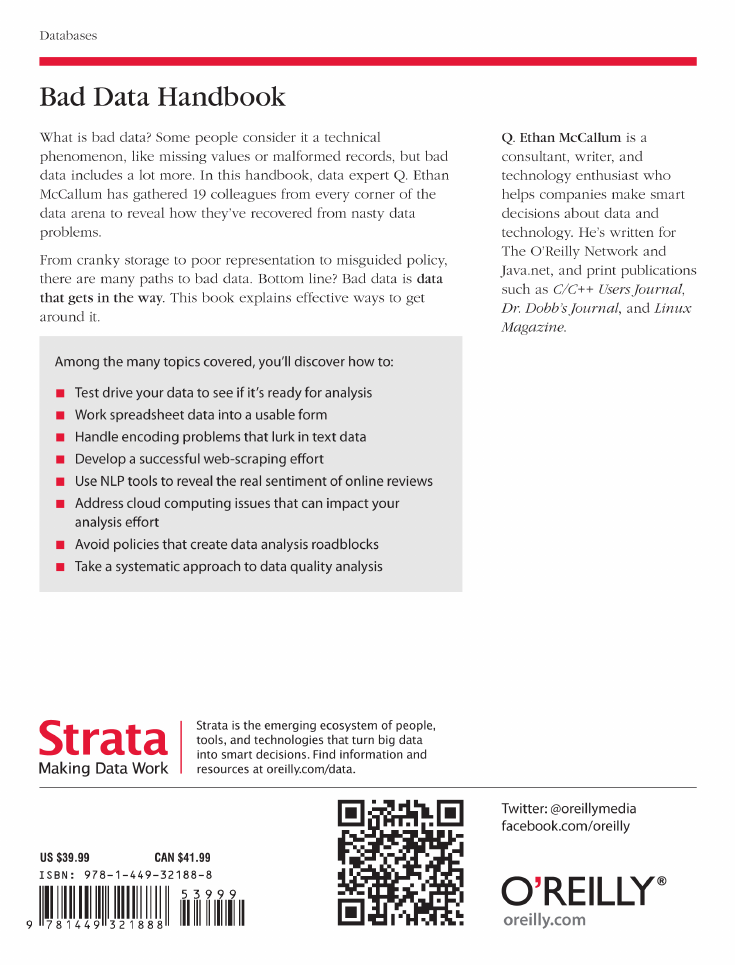
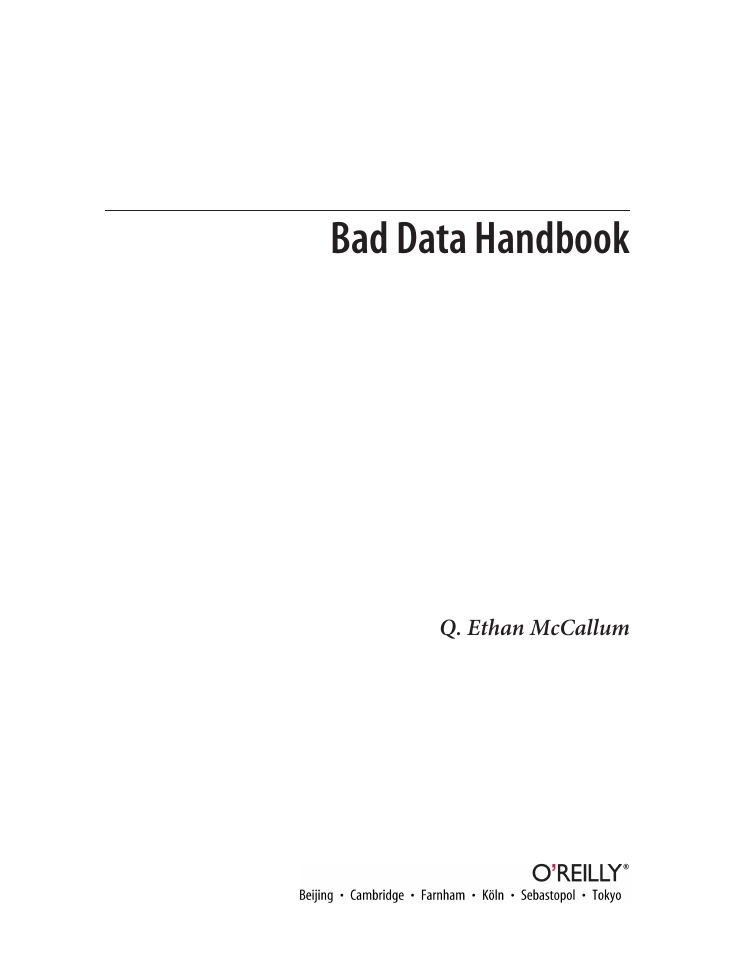
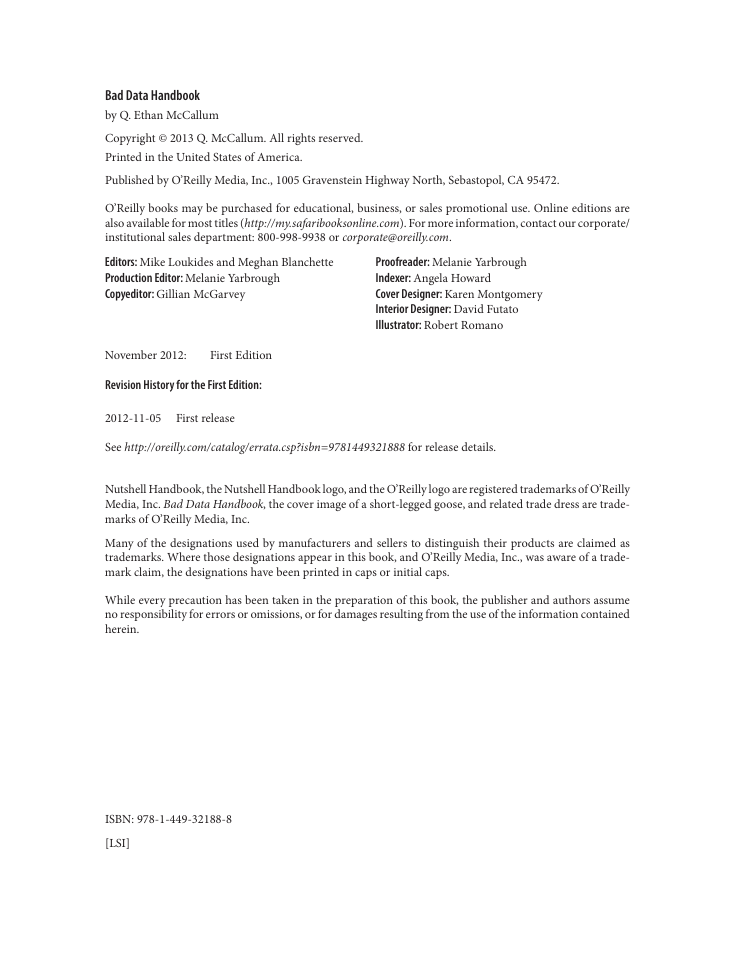


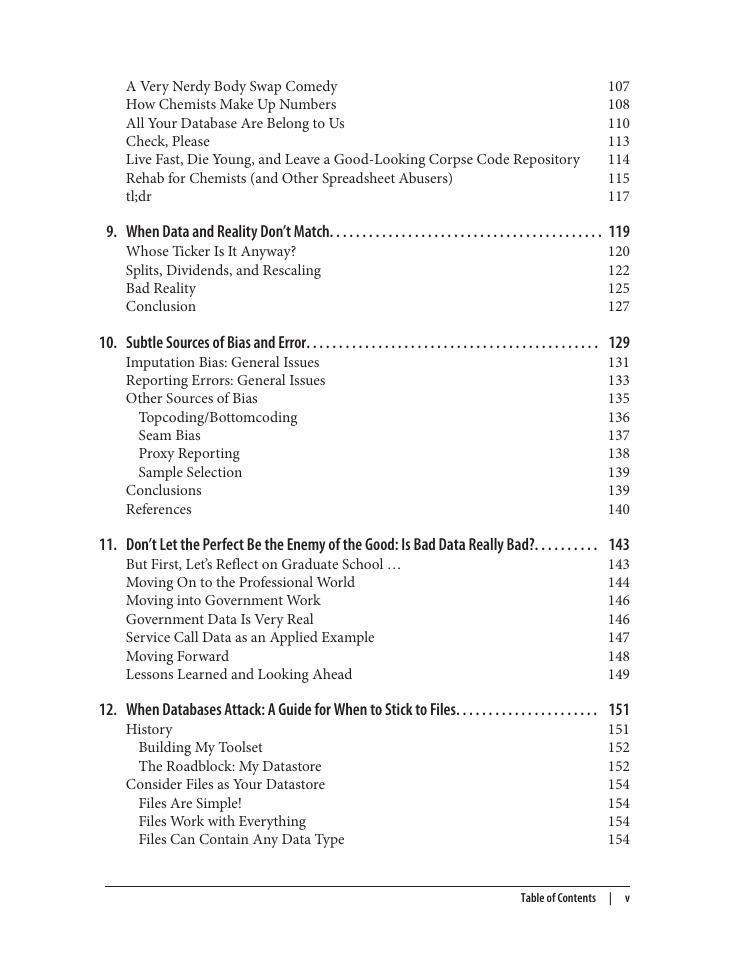
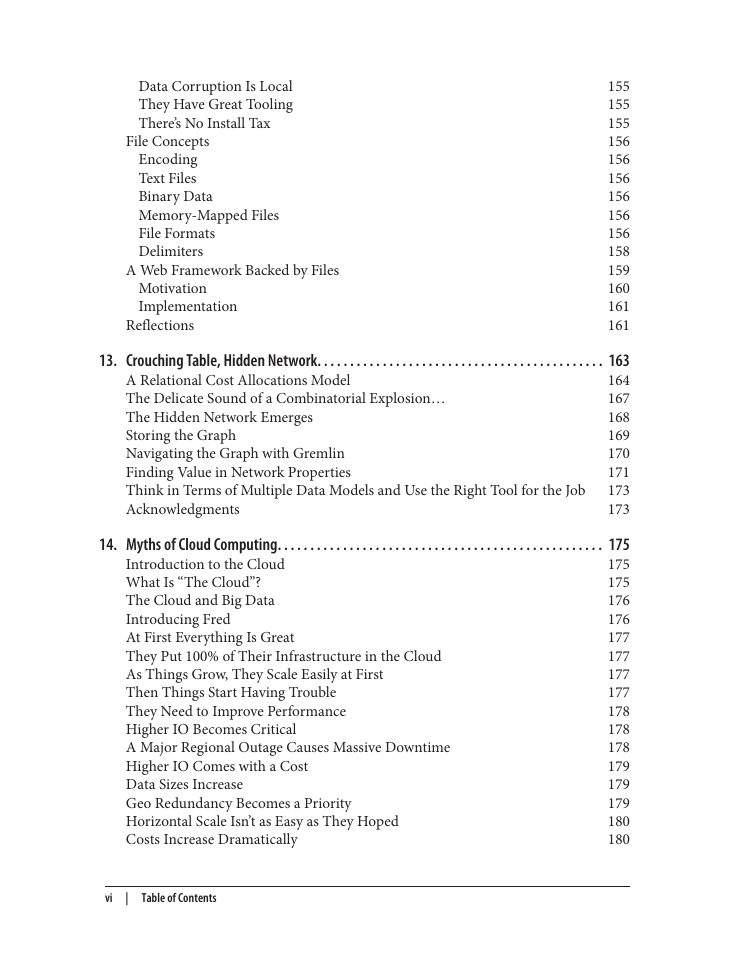








 2023年江西萍乡中考道德与法治真题及答案.doc
2023年江西萍乡中考道德与法治真题及答案.doc 2012年重庆南川中考生物真题及答案.doc
2012年重庆南川中考生物真题及答案.doc 2013年江西师范大学地理学综合及文艺理论基础考研真题.doc
2013年江西师范大学地理学综合及文艺理论基础考研真题.doc 2020年四川甘孜小升初语文真题及答案I卷.doc
2020年四川甘孜小升初语文真题及答案I卷.doc 2020年注册岩土工程师专业基础考试真题及答案.doc
2020年注册岩土工程师专业基础考试真题及答案.doc 2023-2024学年福建省厦门市九年级上学期数学月考试题及答案.doc
2023-2024学年福建省厦门市九年级上学期数学月考试题及答案.doc 2021-2022学年辽宁省沈阳市大东区九年级上学期语文期末试题及答案.doc
2021-2022学年辽宁省沈阳市大东区九年级上学期语文期末试题及答案.doc 2022-2023学年北京东城区初三第一学期物理期末试卷及答案.doc
2022-2023学年北京东城区初三第一学期物理期末试卷及答案.doc 2018上半年江西教师资格初中地理学科知识与教学能力真题及答案.doc
2018上半年江西教师资格初中地理学科知识与教学能力真题及答案.doc 2012年河北国家公务员申论考试真题及答案-省级.doc
2012年河北国家公务员申论考试真题及答案-省级.doc 2020-2021学年江苏省扬州市江都区邵樊片九年级上学期数学第一次质量检测试题及答案.doc
2020-2021学年江苏省扬州市江都区邵樊片九年级上学期数学第一次质量检测试题及答案.doc 2022下半年黑龙江教师资格证中学综合素质真题及答案.doc
2022下半年黑龙江教师资格证中学综合素质真题及答案.doc